Pho’s steam and warmth can help soothe a sore throat. Nutrient-rich broth from bones may support the immune system. Adding anti-inflammatory ingredients like ginger can enhance pho’s soothing effects.
When you’re grappling with the discomfort of a sore throat, you may reach for remedies that soothe and alleviate the pain. Pho, a traditional Vietnamese noodle soup, is often sought after for its comforting warmth and steam. With its nutrient-rich ingredients, such as meat bones, aromatics, and spices, a bowl of pho serves not only as a tasty meal but also as a potentially soothing home remedy for sore throats.
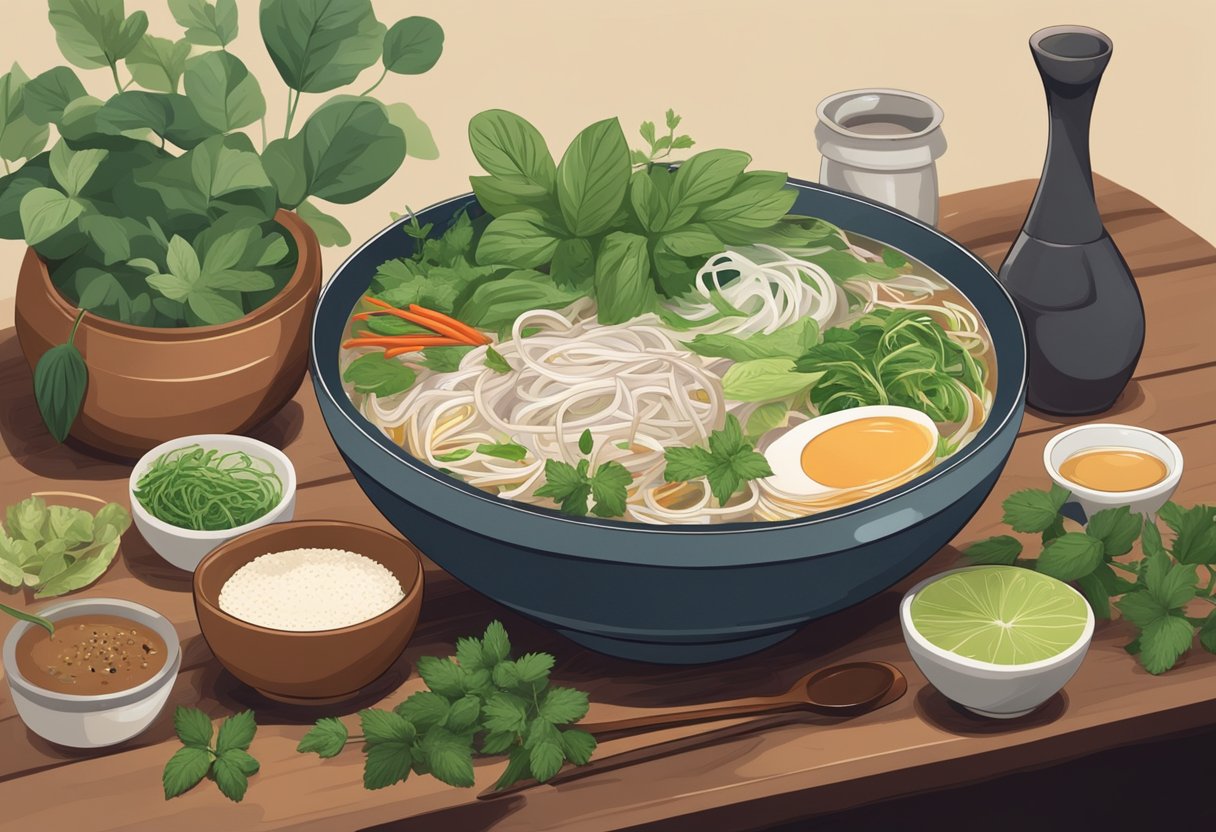
The soup’s warmth and steam can help in thinning mucus and soothing the throat, while the broth, often made from simmering bones, provides nutrients that may support the immune system. Creating an ideal environment for collagen production from the bones, important amino acids make their way into the broth. Furthermore, the customization of pho allows individuals to add ingredients like ginger and garlic, which have been recognized for their anti-inflammatory properties.
What Is Pho?
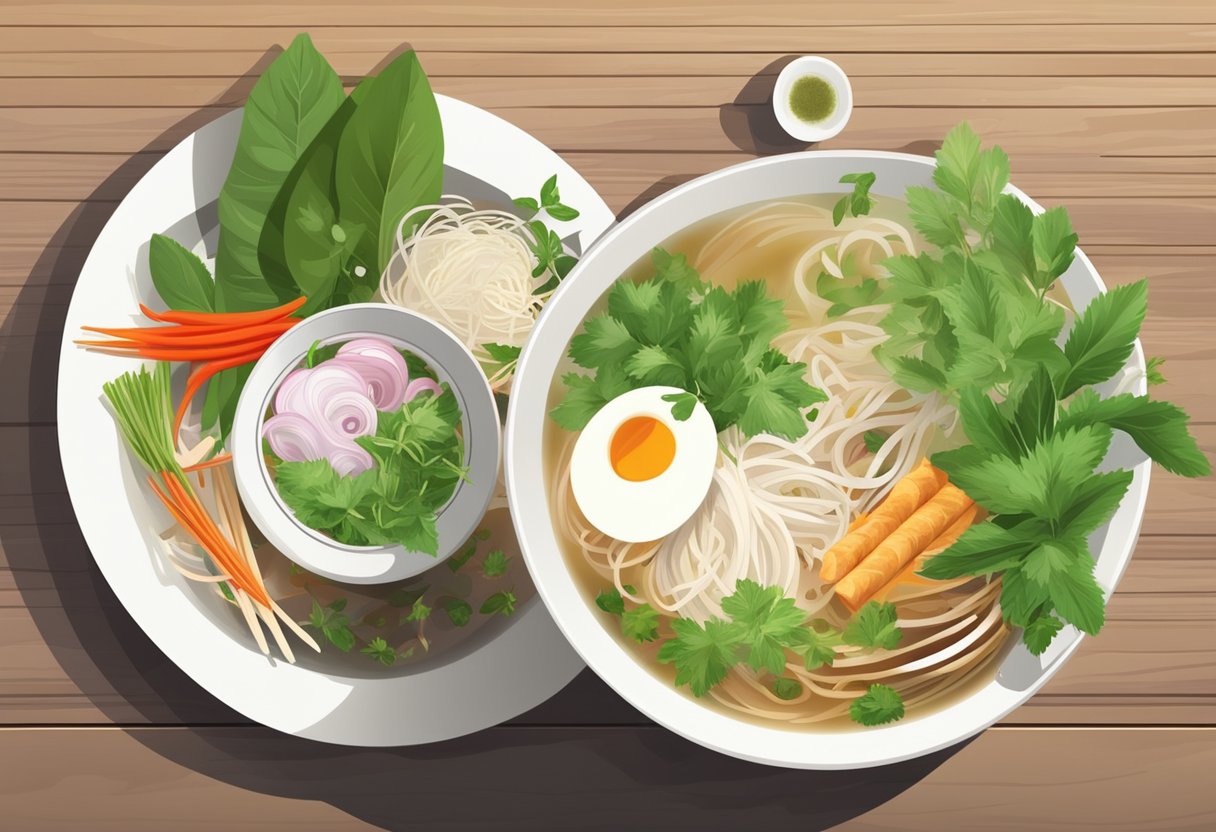
Pho is a Vietnamese soup that consists of broth, rice noodles, herbs, and meat, usually beef or chicken. This classic dish is a staple in Vietnamese cuisine and is known for its rich flavors, which come from a well-prepared stock and a variety of fresh toppings.
The Key Ingredients in Pho
The success of a good bowl of pho largely depends on its two key components: the broth and the rice noodles.
-
Broth: A robust and aromatic stock forms the soul of the soup. It is typically made by simmering meat bones with aromatics such as onion, ginger, and spices including star anise, cinnamon, and cloves. A proper broth requires hours of simmering to extract the full depth of flavors.
Aromatic Common Spices Purpose Onion Star Anise Flavor base Ginger Cinnamon Adds warmth Cloves Adds spiciness Coriander Enhances fragrance Fish sauce Saltiness and umami Rice Noodles: Thin, flat, and made from rice flour, these noodles are a distinguishing feature of pho. They should be cooked just enough to be tender yet retain a slight chewiness.
- Smooth texture.
- Absorbs flavors well.
- Gluten-free option for those with dietary restrictions.
Together with toppings such as slices of beef, chicken, or meatballs, and garnishes like basil, lime, chili, and bean sprouts, pho offers a balanced and hearty dish that can be enjoyed at any time of day.
Nutritional Benefits of Pho Ingredients

Pho, a traditional Vietnamese soup, is renowned for its rich flavors and potential health benefits, particularly when made with wholesome ingredients. Its components, such as bone broth, lean proteins, and vegetables, offer a symphony of nutrients valuable for health.
What Are the Health Benefits of Bone Broth?
Bone broth is a powerhouse of nutrition particularly rich in minerals that are released from bones during the cooking process. Beef pho, for example, often comes with a substantial bone broth. Here’s a breakdown of its benefits:
- Minerals: Provides calcium, magnesium, phosphorus, silicon, sulphur, and others.
- Collagen: Converts to gelatin, which may support joint health.
- Amino Acids: Supplies arginine, glycine, proline, and glutamine, which can support immune function.
Which Vitamins and Minerals Are Found in Vegetables?
Vegetables add essential vitamins and minerals to pho, enhancing its nutritional profile. Consuming a variety of vegetables in pho contributes to an increased intake of these key nutrients:
- Vitamins: Such as A, C, K, as well as B-complex vitamins.
- Minerals: Including iron, manganese, and potassium.
Typical vegetables in pho might include bean sprouts, basil, cilantro, onions, and sometimes bok choy or broccoli.
How Do Lean Protein Sources Benefit Health?
Lean proteins are fundamental for muscle repair and immune health. They are an integral component of pho, which can be prepared with a variety of protein sources. The lean protein in pho can come from:
- Chicken: Often compared with chicken soup for its comfort food status; a great source of lean protein.
- Beef: Common in beef pho, offering protein as well as vitamins like B12.
- Tofu: A plant-based option that delivers protein along with a texture that absorbs the flavors of the broth.
- Seafood: Options like shrimp or fish add a different profile of nutrients and lean protein.
Incorporating a range of lean proteins can cater to different dietary needs while ensuring the body receives a complete amino acid profile.
Is Pho Good for Sore Throat Relief?
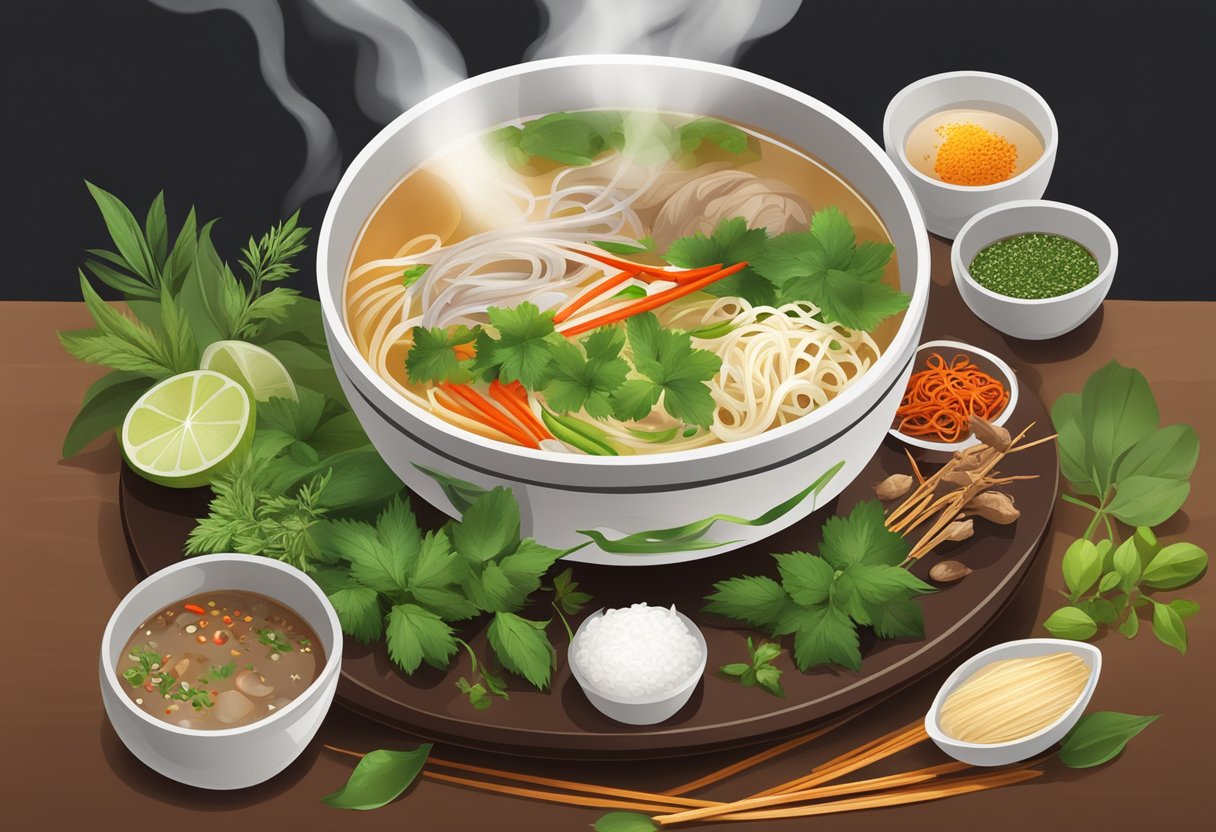
Pho, a Vietnamese soup consisting of broth, rice noodles, herbs, and meat, can offer comfort and relief for those suffering from a sore throat due to its hot broth and herbs.
Warmth and Steam
Pho’s hot broth provides warmth, which can be soothing for a sore throat. The steam from the broth may help in the following ways:
- Moisturizing the throat: Dryness can exacerbate sore throat discomfort.
- Loosening mucus: This can aid in clearing the throat of irritants.
| Benefit | Description |
|---|---|
| Moisture | The steam adds humidity to the throat. |
| Mucus Loosening | Inhalation of steam helps thin mucus. |
Spices and Herbs as Natural Remedies
The spices and herbs in pho can act as natural remedies, contributing to sore throat relief. Components like fresh ginger have properties that may help:
-
Fresh ginger: Known for its anti-inflammatory effects.
-
Other herbs and spices: May aid in immune support and act as antioxidants.
-
Anti-inflammatory: Certain spices can reduce inflammation.
-
Antioxidants: Herbs can have antioxidant properties that support overall health.
| Ingredient | Property |
|---|---|
| Ginger | Anti-inflammatory |
| Herbs | Antioxidant Support |
Is Hot Soup a Remedy for a Sore Throat?

Hot soup can serve as a soothing remedy for a sore throat. Its steam and warmth help in decreasing throat inflammation and provide relief. Chicken soup, often regarded as a traditional remedy for colds and flu, is a popular choice due to its combination of heat, hydration, and nutrients that bolster the immune system.
While not all soups are created equal, the Vietnamese noodle soup known as “pho” embodies many qualities of an ideal soothing agent for sore throats.
| Components of Pho | Healing Qualities |
|---|---|
| Broth (often chicken) | Rich in nutrients and hydrating |
| Herbs and Spices | Natural anti-inflammatories |
| Heat from the Broth | Soothing warmth |
Vietnamese food, like pho, features a delicate balance of ingredients that promote healing. Here are some elements in hot soup that contribute to its healing powers:
- Hydration: Soups provide fluid to keep the throat moist and defend against irritation.
- Warmth: The temperature of hot soup can calm a sore throat and alleviate discomfort.
- Nutrients: Soups like chicken pho are packed with protein, vitamins, and minerals essential for recovery.
- Herbs and Spices: Many Vietnamese recipes include ingredients like ginger and garlic that have natural antibacterial properties.
Hot soup is not just a meal; it’s comfort in a bowl that may aid in recovery from a sore throat without the use of medication.
Pho Preparation Methods
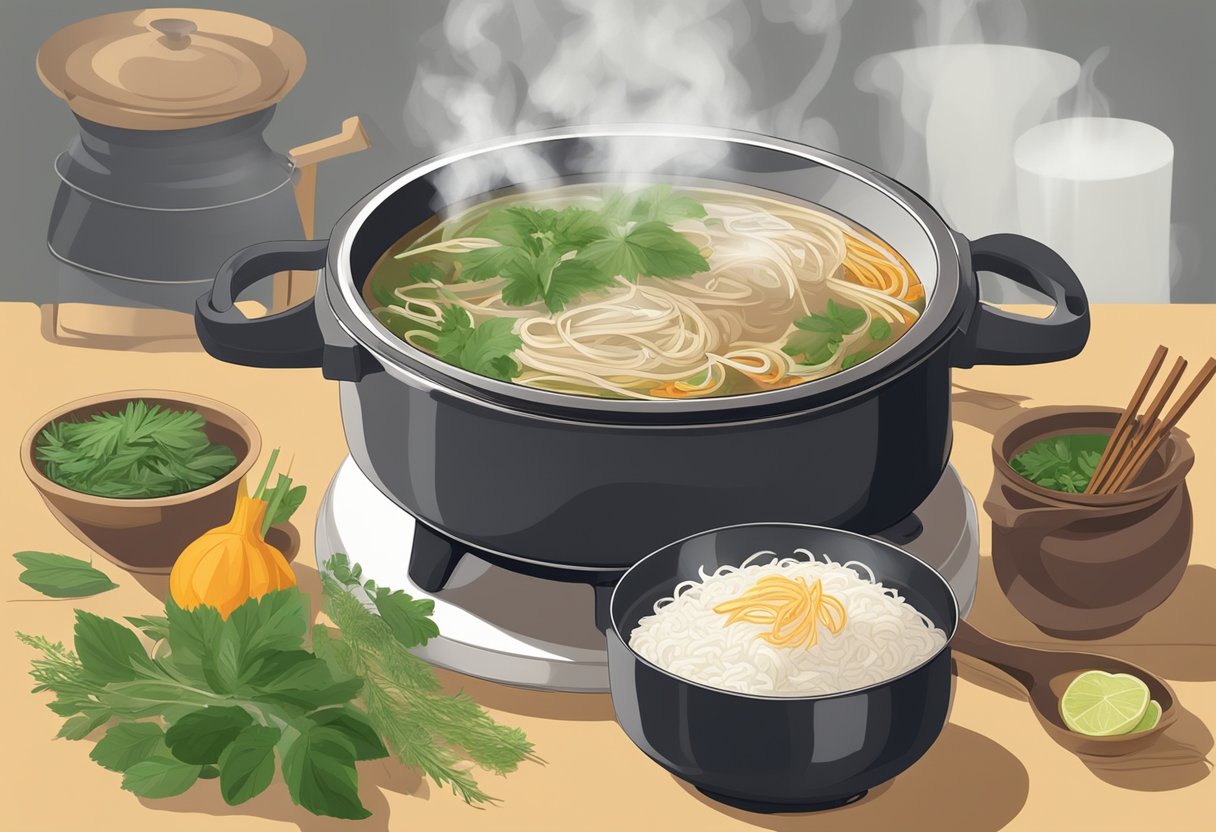
Pho, the aromatic Vietnamese noodle soup, can be prepared using various techniques, ranging from traditional methods that require hours of simmering to modern approaches using kitchen gadgets like the Instant Pot.
Traditional Pho Cooking Techniques
Traditional pho is known for its depth of flavor, which arises from its lengthy and intricate cooking process. One generally starts by:
Parboiling bones: Bones are initially boiled to remove impurities.
- Place bones in a large pot, cover with water, and bring to a boil.
- Once a gray foam forms, drain and rinse the bones.
Simmering the broth: The clear broth is achieved by simmering for an extended period.
- Return the cleaned bones to the pot, fill with fresh water and bring to a simmer.
- Cook for several hours, traditionally between 3 to 10.
Cooking aromatics:
- Spices like star anise, cinnamon, and cardamom give pho its signature fragrance.
- These are roasted lightly to enhance their flavors before being added to the broth.
One should also:
- Skim off excess fat and impurities that rise to the top during simmering.
- Strain the broth through a fine-mesh sieve for clarity and purity of flavor.
Modern Methods with Instant Pot
Instant Pot significantly reduces the cooking time for pho while maintaining rich flavors. The steps include:
Initial bone prep: Similar to traditional methods, begin by parboiling bones.
- Parboil the bones using the ‘Saute’ function on the Instant Pot, then rinse.
Pressure cooking the broth:
- Place the cleaned bones back in the Instant Pot with water.
- Add the spices and set the pot on the ‘Soup/Broth’ setting for a shorter time, typically 1 to 2 hours.
Using the Instant Pot has distinctive advantages:
- Time efficiency: A traditionally long process is condensed into a fraction of the time.
- Flavor concentration: The sealed environment of the Instant Pot can result in a broth that is rich and flavorful.
- Consistency: The automatic settings reduce the need for constant monitoring, ensuring consistent results with each batch.
Note: Tables and bullet points are not ideally suited for this particular section as they would interrupt the flow of step-by-step cooking instructions that are better suited to the paragraph format used.
What Toppings and Condiments Can Enhance Pho?
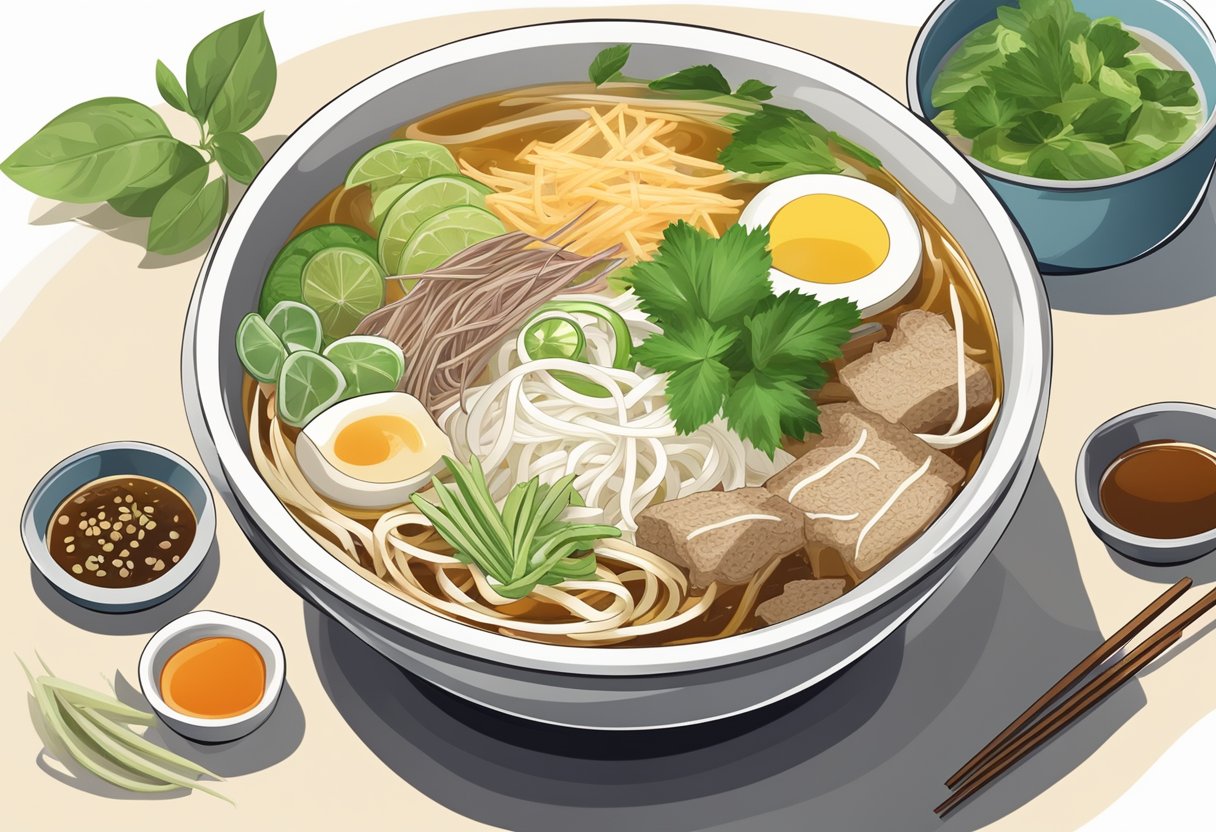
A variety of toppings and condiments can be added to pho to enhance its flavor, each contributing its own unique taste and texture:
| Toppings | Description |
|---|---|
| Bean sprouts | Provide a crunchy texture and a nutty flavor to the soup. |
| Thai basil | Adds a peppery and slightly sweet flavor. |
| Lime juice | Contributes a bright, citrusy note. |
Condiments such as hoisin sauce and fish sauce are often served on the side, allowing individuals to adjust the flavor of their pho to their preference. They should be used sparingly to not overpower the delicate taste of the broth.
- Hoisin sauce: It brings a sweet and tangy element that complements the savory broth.
- Fish sauce: Offers an umami depth and saltiness that can intensify the overall flavor profile.
- Soy sauce: Some diners prefer a dash of soy sauce for an additional layer of saltiness and umami.
It’s traditional to find a small plate of these accompaniments next to a steaming bowl of pho, allowing each person to tailor their dish according to their taste. The use of fresh herbs and citrus juice not only pleases the palate but also contributes to the aromatic experience of enjoying pho.
How Can You Customize Your Bowl of Pho?
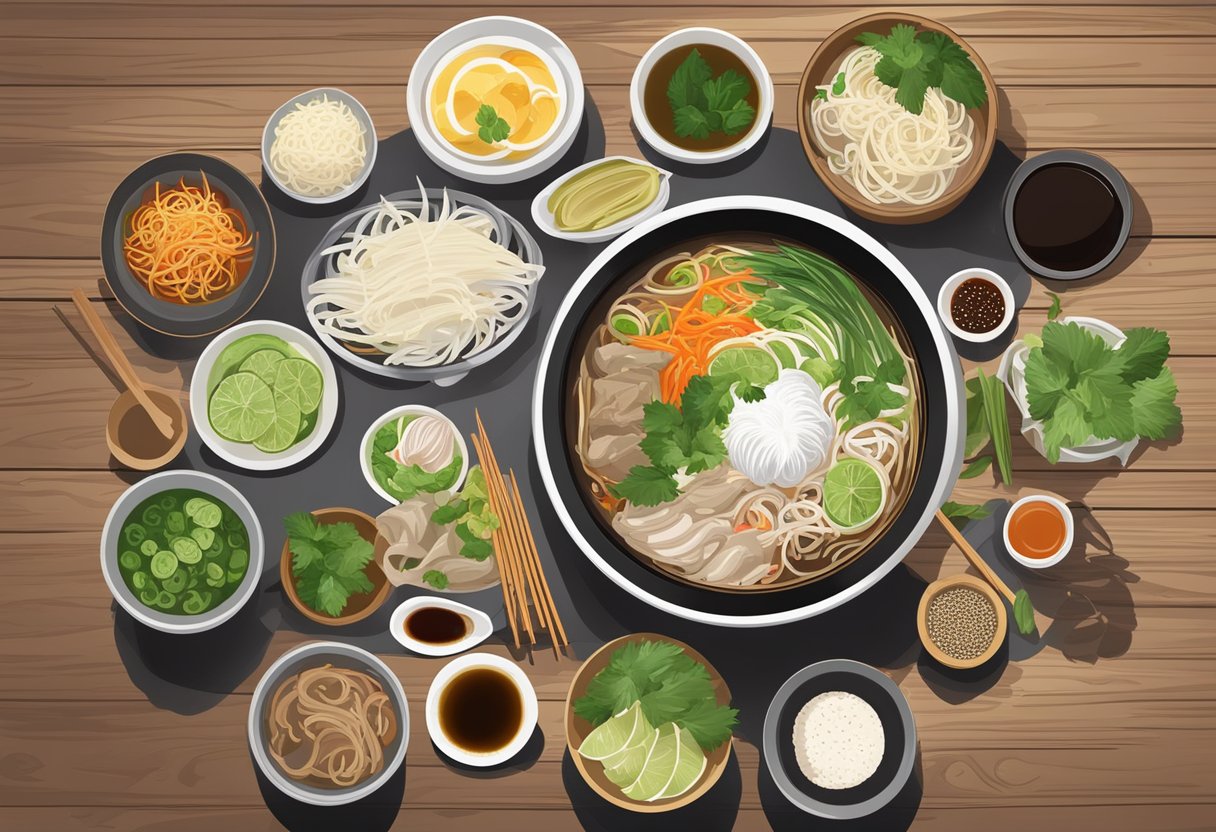
Customizing a bowl of pho to one’s individual taste can greatly enhance the eating experience. Typically, pho comes with a host of fresh ingredients and condiments allowing each person to tailor the soup to their preferences, making it an ideal meal for those with a sore throat who may require a more soothing or less spiced version.
Ingredients to Choose From:
-
Noodles: Rice noodles are the base of pho and can be left as is for a classic experience.
Proteins:
- Beef: Slices of rare beef that cook in the broth
- Chicken: A lighter option for those who prefer poultry
Vegetables:
- Bean sprouts
- Sliced onions
- Green onions
- Basil leaves
- Cilantro
Optional Add-ons:
Herbs and Spices:
- Ginger, for its soothing qualities
- Fresh chili, to heat and potentially relieve congestion
- Lime wedges, for a touch of zest and vitamin C
Sauces:
- Hoisin sauce, for sweetness and depth
- Fish sauce, for umami and saltiness
- Sriracha, for a spicy kick
One can begin by tasting the broth before adding any ingredients. This allows for understanding the foundation of flavors before enhancing them. For someone with a sore throat, starting with a clear, less spicy broth and adding in gentle herbs like basil and cilantro can be comforting. Ginger is an excellent addition for its throat-soothing properties.
When dealing with a sore throat, it may be wise to limit or avoid the spicy components such as fresh chili and sriracha. This approach tends to maintain a mild, throat-comforting meal while still enjoying the rich flavors of traditional pho.
Is Pho Beneficial During Cold and Flu Season?
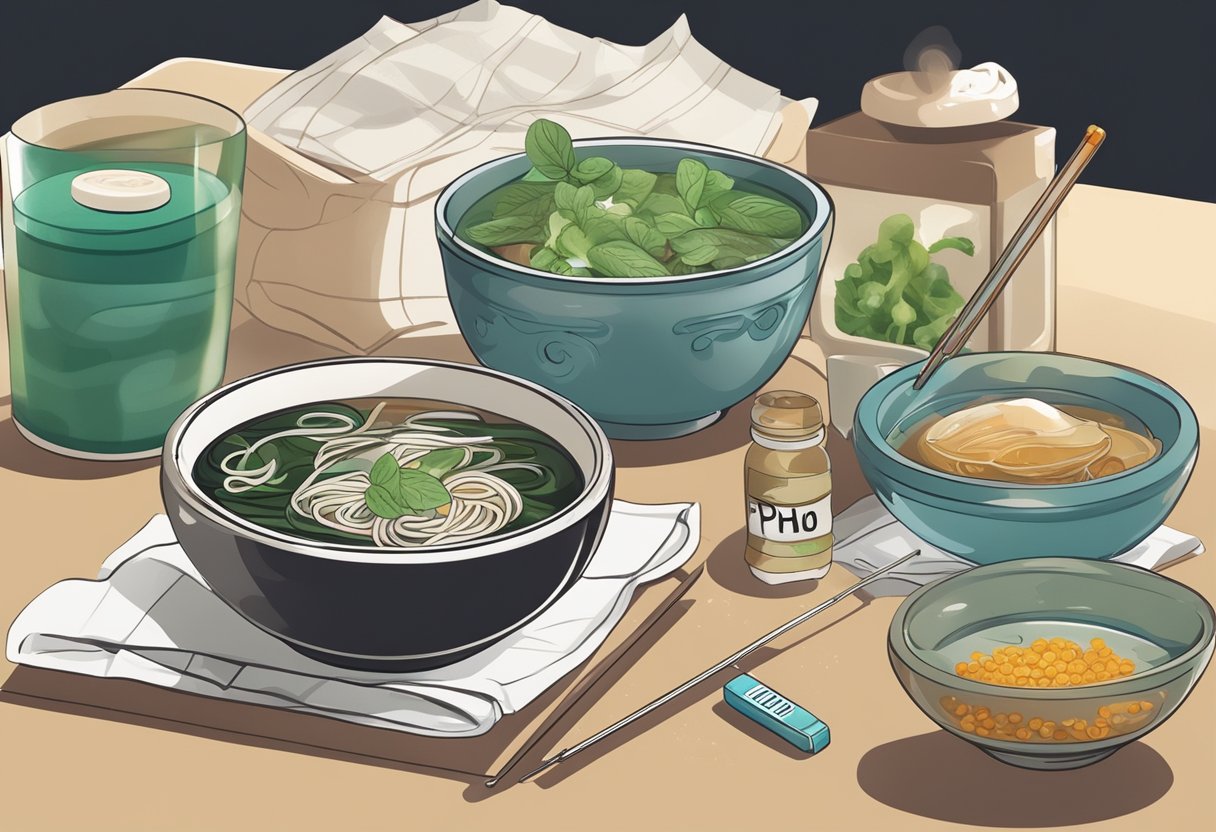
Yes, pho can be beneficial during cold and flu season. It is a Vietnamese noodle soup that many consider comfort food, especially during the colder months when respiratory issues are more common. A bowl of pho is both warming and nourishing, providing hydration and potentially helping to alleviate symptoms of colds and flu.
Nutritional Profile of Pho:
| Ingredient | Benefits |
|---|---|
| Broth | Hydrates and helps with nasal congestion |
| Spices (e.g., ginger, onion) | May have anti-inflammatory properties |
| Protein (meat or tofu) | Essential for repair and recovery of the body |
| Noodles | Provides carbohydrates for energy |
| Herbs (e.g., basil, cilantro) | Rich in vitamins and antioxidants |
Reasons Pho is Considered Comfort Food:
- Warmth: The hot broth can soothe a sore throat and make one feel more comfortable.
- Aroma: The spices and herbs contribute to a strong, pleasant aroma that can help clear nasal passages.
- Ease of Digestion: Pho is generally easy on the stomach, which is ideal for someone who may not have much appetite.
Pho’s ingredients, such as ginger and onion, have been mentioned for their potential to support immune function, though one should not rely solely on pho to heal or prevent illness. It offers a combination of hydration, nutrients, and warmth that may support recovery during flu season.
How Can You Identify Authentic Vietnamese Pho?
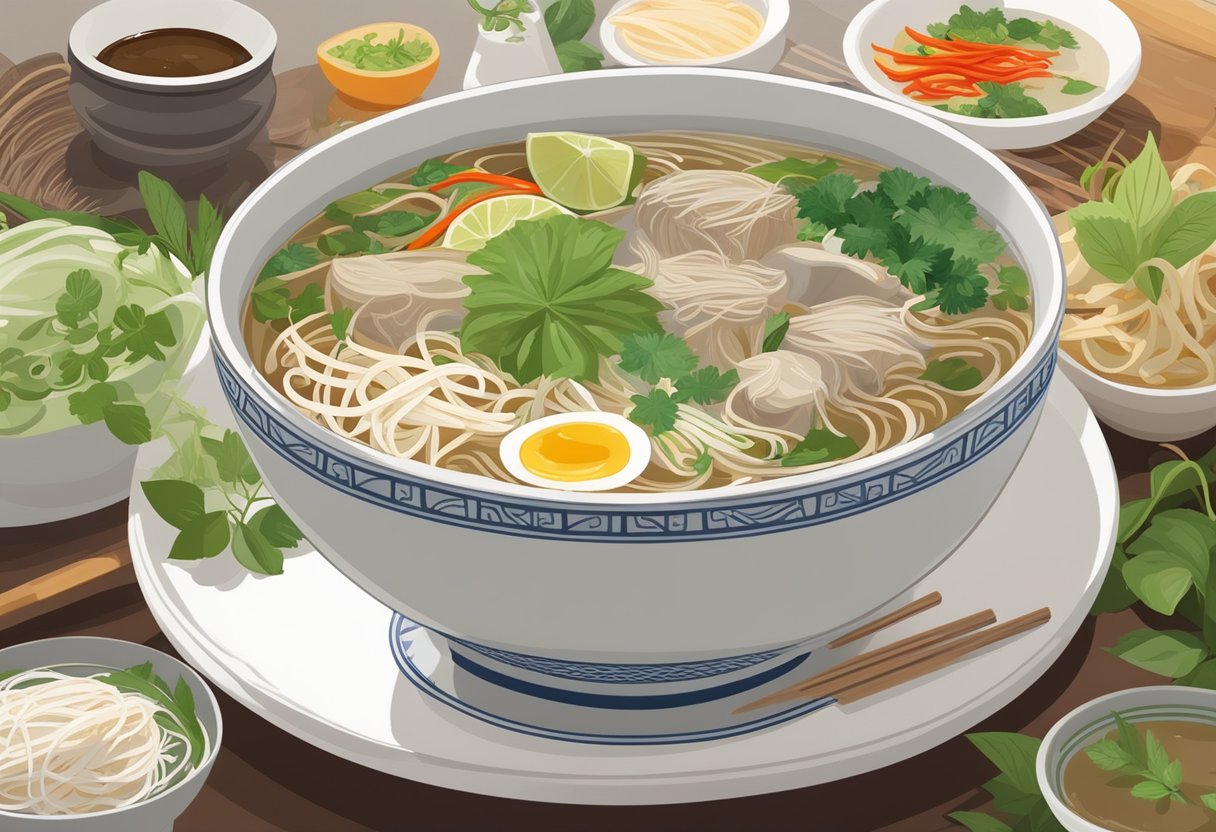
Authentic Vietnamese Pho is recognized by its flavorful broth, fresh ingredients, and the balance of spices. When searching for genuine Vietnamese Pho, connoisseurs consider several key characteristics that denote authenticity.
In Vietnamese restaurants, one should look for:
- Broth Clarity: The broth should be clear and not cloudy, achieved by meticulously skimming off impurities.
- Spices and Aromatics: A hallmark of Pho is the use of star anise, cinnamon, roasted ginger, and onions, contributing to the soup’s distinctive aroma and taste.
- Fresh Herbs and Accoutrements: Authentic Pho is served with a plate of fresh herbs like Thai basil, cilantro, and mint, along with bean sprouts, lime wedges, and sliced chilies.
| Ingredient | Role in Pho |
|---|---|
| Beef Bones | Base stock foundation |
| Star Anise | Licorice-like flavor |
| Cinnamon | Warm, sweet aroma |
| Roasted Ginger | Pungent, fiery touch |
| Charred Onion | Sweetness and depth |
| *Herbs/Condiments | Customizable garnishes |
A visit to a Vietnamese food venue opens one’s palate to flavors that are:
- Rich and Complex: The broth simmers for hours, extracting flavors from beef bones and spices.
- A Harmony of Tastes: Balance between sweet, salty, sour, and umami profiles.
- Cultural Integrity: Traditional methods and preparations signal a dedication to Vietnamese culinary customs.
Remember, an authentic Pho is not just about being delicious but staying true to its Vietnamese origins, combining fresh, quality ingredients with time-honored cooking techniques.
Is Pho a Complete Meal?
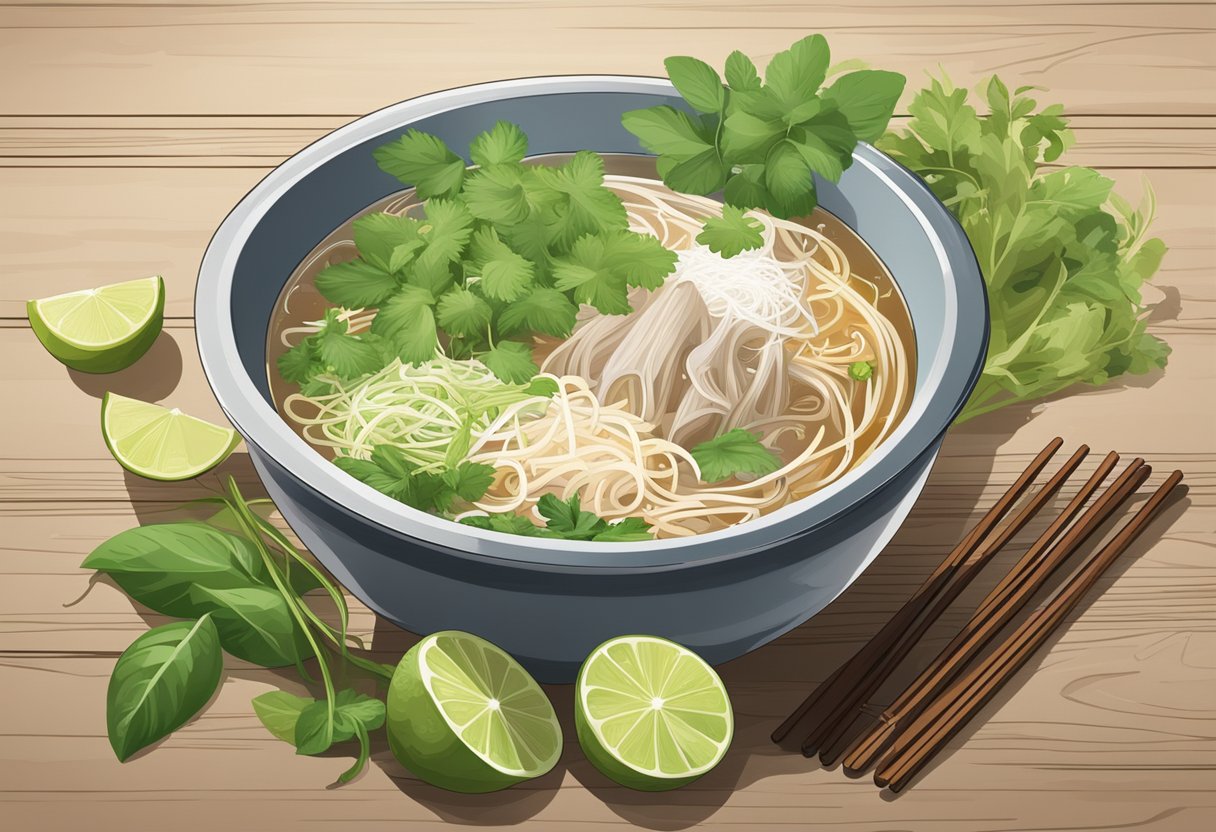
Yes, pho is considered a complete meal, offering a balance of noodles, proteins, vegetables, and herbs immersed in a flavorful broth.
Noodles
Pho typically contains:
- Rice noodles: A staple component that provides carbohydrates and texture.
Broth
The base of pho is its:
- Broth: A complex, rich liquid carrying depth from spices and bones, contributing to a soothing effect on a sore throat.
Protein
Various protein options include:
- Meat: Such as beef, chicken, or tofu, delivering essential proteins.
Veggies and Herbs
The dish is garnished with:
- Veggies: Like bean sprouts and onions, adding freshness and nutrients.
- Herbs: Basil or cilantro, infusing aroma while imparting potential anti-inflammatory benefits.
All the Flavors
The harmonious mix of all elements creates a symphony of flavors that contribute to the appeal and nutritional value of pho, making it a hearty and nourishing option for those seeking a meal that is both satisfying and capable of providing comfort during illness.
Is Pho Good for Savoring the Experience?
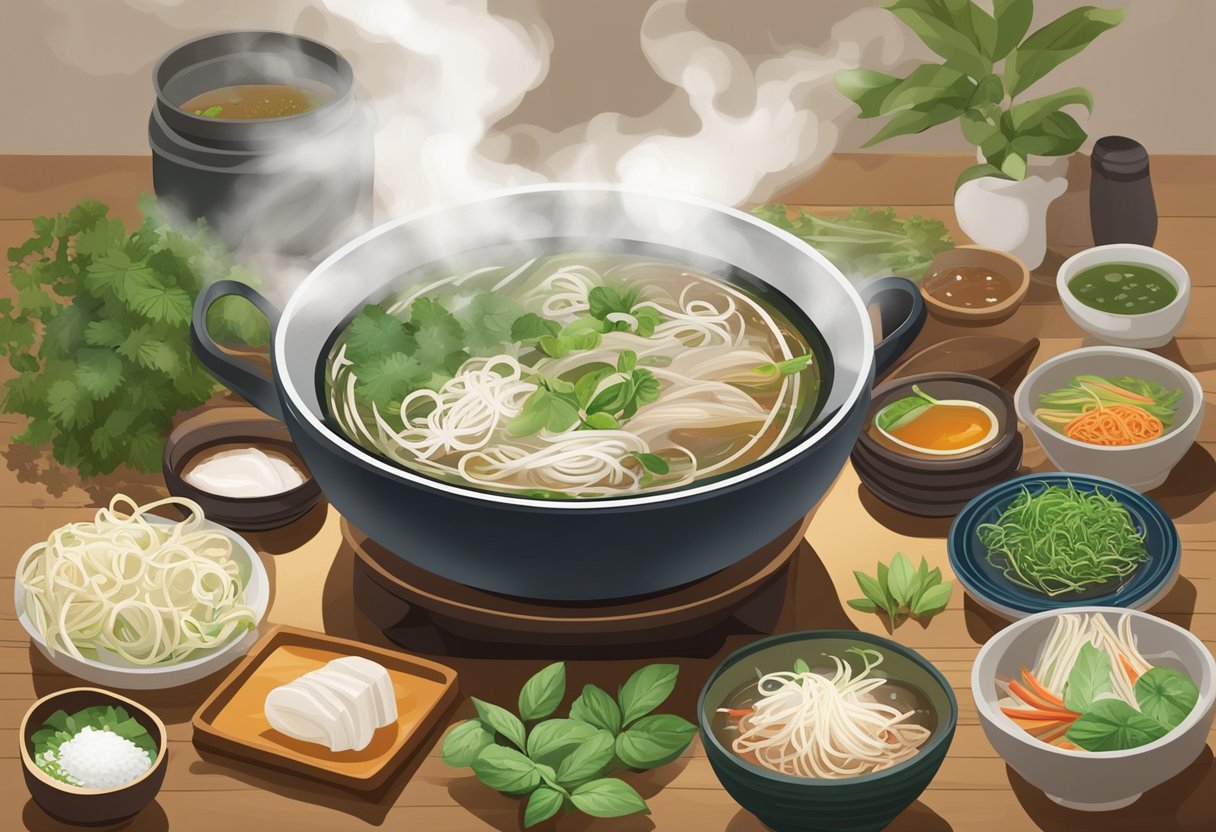
Yes, pho is excellent for savoring the experience due to its complex flavors and warm broth, which can be especially comforting when one has a sore throat. When eating pho, individuals often find the act of slurping not only enjoyable but also soothing. The steam from the bowl can help to moisturize the throat, and the act of slurping can ease discomfort.
Here are key aspects of the pho experience:
- Slurping: It’s an essential part of enjoying pho. It cools the broth and noodles just enough to eat comfortably and enhances the dish’s flavors.
- Taste: A rich, aromatic broth paired with herbs and spices offers a delightful taste experience that can be gentle on a sore throat.
- Eat: Pho is typically consumed with a combination of noodles, broth, herbs, and sometimes meat, making it a substantial meal.
| Component | Role in Savoring the Experience |
|---|---|
| Warm broth | Soothes the throat and eases discomfort |
| Aromatic herbs | Provides a sensory pleasure |
| Noodles | Soft texture that is easy to eat |
| Tender meats | Offer protein without requiring much chewing |
Those who love pho appreciate its versatility. It can be served with a variety of garnishes that allow personalization according to taste preferences, and ingredients can be adjusted to suit dietary needs or to ease a sore throat. The broth can be sipped separately, helping to stay hydrated, which is vital when managing throat irritation.
Frequently Asked Questions
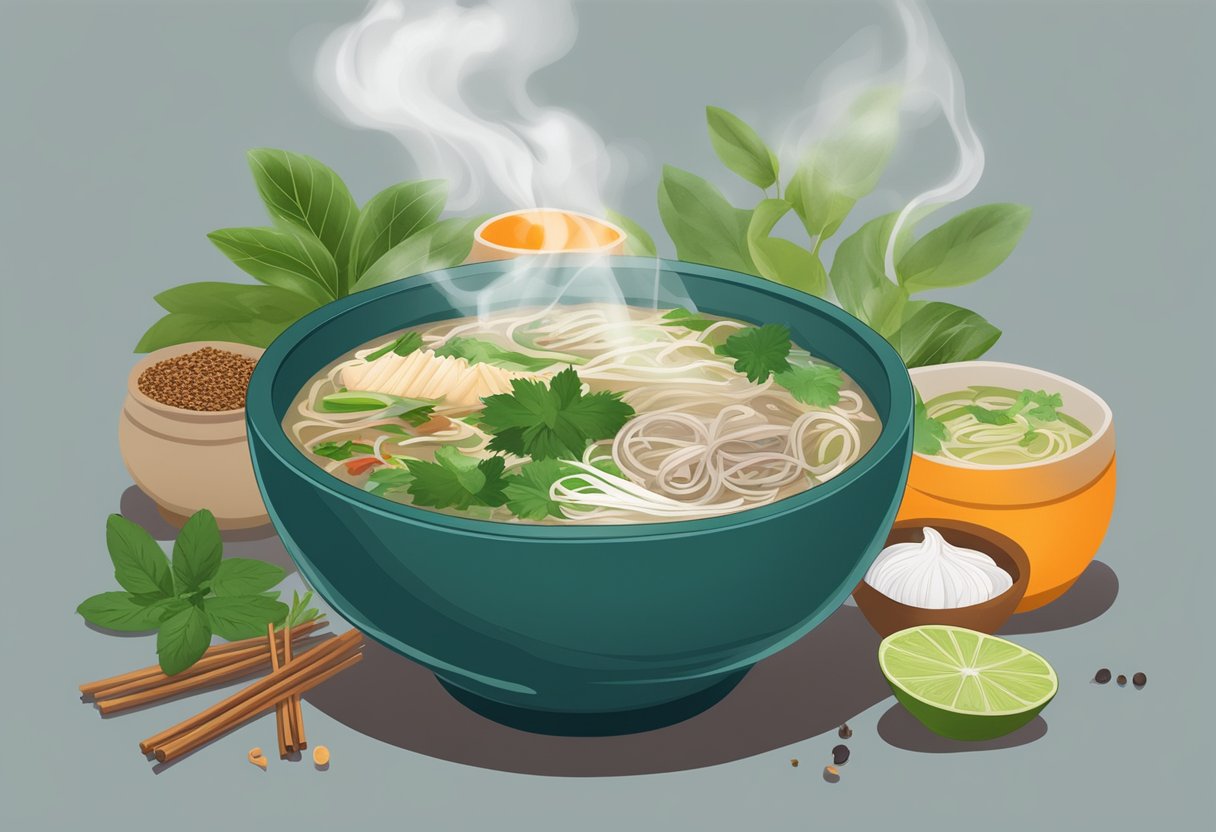
In this section, we address common inquiries about consuming pho for sore throat relief, covering the types of pho that are beneficial, their properties, and recommendations for particular conditions.
Can pho help alleviate symptoms of a sore throat?
Yes, pho can help soothe a sore throat. The warm broth can provide comfort by moistening the throat, and the steam may help in reducing throat irritation.
- Properties of pho that aid in alleviation:
- Warmth of the broth
- Steam to ease breathing
What type of pho is most beneficial for a cough?
Chicken pho is often recommended for a cough. It is easier to digest and the broth can help with hydration and maintaining a moist throat.
- Factors contributing to the benefit:
- Chicken broth as a base
- Gentle on the stomach
Are there benefits to eating pho when experiencing tonsillitis?
Yes, pho may offer benefits for those with tonsillitis. Its warm broth can be soothing, and the inclusion of herbs and spices may bring some relief.
- Soothing elements in pho for tonsillitis:
- Warmth from the broth
- Beneficial herbs like ginger
Should one prefer chicken or beef pho when feeling unwell?
Chicken pho is generally preferred when unwell. It’s typically lighter and the broth can help support the immune system.
- Comparison in table form:
| Chicken Pho | Beef Pho |
|---|---|
| Lighter broth | Richer broth |
| Easier to digest | Heavier, can be more robust in flavor |
Does pho possess anti-inflammatory properties that can aid in treating a cold?
Pho can have anti-inflammatory properties. The herbs and spices like ginger and garlic used in pho have anti-inflammatory qualities.
- Anti-inflammatory ingredients in pho:
- Ginger
- Garlic
What Vietnamese soup is recommended for sore throat relief?
Pho is a widely recommended Vietnamese soup for sore throat relief. Its warmth, steam, and nourishing ingredients can provide soothing benefits.
- Components of pho aiding in relief:
- Clear and warm broth
- Soft noodles and tender meats for easy swallowing
